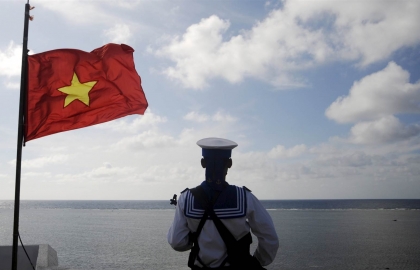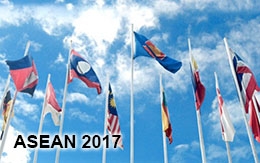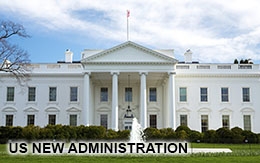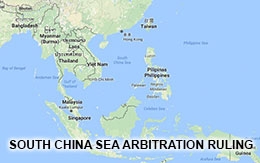Rebalancing: Vietnam’s South China Sea Challenges and Responses
The South China Sea persists as the leading security and development challenge for Vietnam. In Hanoi’s view, the situation in the South China Sea affects almost all aspects of national security and development: protecting territorial integrity and national sovereignty; promoting maritime economic development; maintaining an external peaceful environment and, in particular, peaceful relationships with China and other claimants; and safeguarding regime legitimacy and internal stability.

The South China Sea persists as the leading security and development challenge for Vietnam. In Hanoi’s view, the situation in the South China Sea affects almost all aspects of national security and development: protecting territorial integrity and national sovereignty; promoting maritime economic development; maintaining an external peaceful environment and, in particular, peaceful relationships with China and other claimants; and safeguarding regime legitimacy and internal stability. This paper analyses Vietnam’s approaches to the current situation in the South China Sea in seeking to achieve its main objectives, and examines the state’s responses with reference to the interactions among relevant states and organisations.
Challenges
There are four prevailing issues that Vietnam needs to address in the South China Sea disputes: (i) its sovereignty claim over ‘land features’ in the Spratlys; (ii) sovereignty over ‘land features’ in the Paracels; (iii) sovereignty rights and jurisdiction within Vietnam’s exclusive economic zone and continental shelf, including management and use of hydrocarbon, mineral resources, and other living resources, especially fishing; (iv) and protecting fishermen and their vessels operating in the overlapping areas of claims, particularly around the Paracel Islands.
Creeping and Diversified Challenges
Although Vietnam’s claims in the South China Sea overlap with five other parties (China, Taiwan, Malaysia, Brunei, and the Philippines), ASEAN claimants have implicitly reached a common understanding in maintaining the status quo of occupation, settling disputes by peaceful means and refraining from activities that can negatively affect the interests of other members. Taiwan’s activities have mainly concentrated on its occupied island, Itu-Aba, the largest feature of the Spratlys, and therefore has not directly threatened Vietnam’s security in the South China Sea. Rather, it is China’s renewed assertiveness in the South China Sea since 2007 that has been widely perceived within Vietnam as encroachment on its sovereignty and maritime interests. China’s assertive and comprehensive approach – expanding military, paramilitary and civilian activities – has raised the frequency of occurrence of incidents in the overlapping area between the so-called ‘U-shaped line’ covering approximately 80 per cent of waters in the South China Sea and Vietnam’s exclusive economic zone and continental shelf.
Resource exploitation in the South China Sea – hydrocarbons and fisheries – constitute the most frequent source of tensions between China and Vietnam. During the period of its unilaterally declared fishing ban between May and August – imposed annually since 1999 – Chinese maritime security forces have repeatedly detained Vietnamese fishermen, confiscated fishing boats, and charged fines for their release. This type of incident occurs most frequently in the Paracel Islands as Vietnamese fishermen continue to catch fish in what are regarded as traditional fishing grounds.
Besides activities at sea, a number of steps adopted by China were perceived by Vietnam as aiming to extend the legal basis for China regarding land features and maritime zones in the South China Sea, and as encroachment on Vietnam’s sovereignty and jurisdiction. This had resulted in diplomatic protest by Vietnam.
Two recent developments – Chinese conduct of reclamation activities in the Spratlys, and deployment of the Chinese oil rig HYSY 981 in the area claimed by Vietnam – attracted considerable attention from the international community and are regarded by Vietnam as the most vivid and worrisome signs of China’s increasing assertiveness in the South China Sea.
Other developments related to the oil rig crisis have ushered in a new dimension in the Vietnamese leadership’s approach to handling maritime issues, whereby the implications for economic development assume increased significance. This reflects populist opinion: for the first time, the oil rig incident not only inflamed anti-China sentiment among the Vietnamese population, but it also provoked large-scale anti-China riots in a number of Vietnamese cities. The likelihood of skirmishes between Chinese and Vietnamese vessels in the SCS escalating into conflict and domestic riots has deleteriously affected the business environment in Vietnam, which until the crisis was widely considered as one of the safest and stable economies in the region.
Although the oil-rig incident is worrisome, it has fallen short of direct conflict and the situation quickly renormalised. Massive land reclamation and construction activities by China in the Spratlys since 2014 has nonetheless permanently destabilised this normalcy, with far-reaching strategic implications for the region. Such construction works have affected the responses of the major powers and the dynamics of the claimants’ relations. China’s expanded military presence in the area has already enhanced Chinese power projection in the South China Sea.
...
Dr. Tran Truong Thuy is Executive Director of the Foundation for East Sea Studies (FESS), Senior Fellow & Deputy Director, Bien Dong Maritime Institute, Diplomatic Academy of Vietnam (DAV).
The paper was presented at the Conference: "The South China Sea in the Broader Maritime Security of the Indo-Pacific Conference", 28-30 September 2016, Canberra, Australia. This conference is co-organized by UNSW Canberra at the Australian Defence Force Academy (ADFA), the Diplomatic Academy of Vietnam (DAV), and the Japan Institute of International Affairs (JIIA).
Click here for full text.










